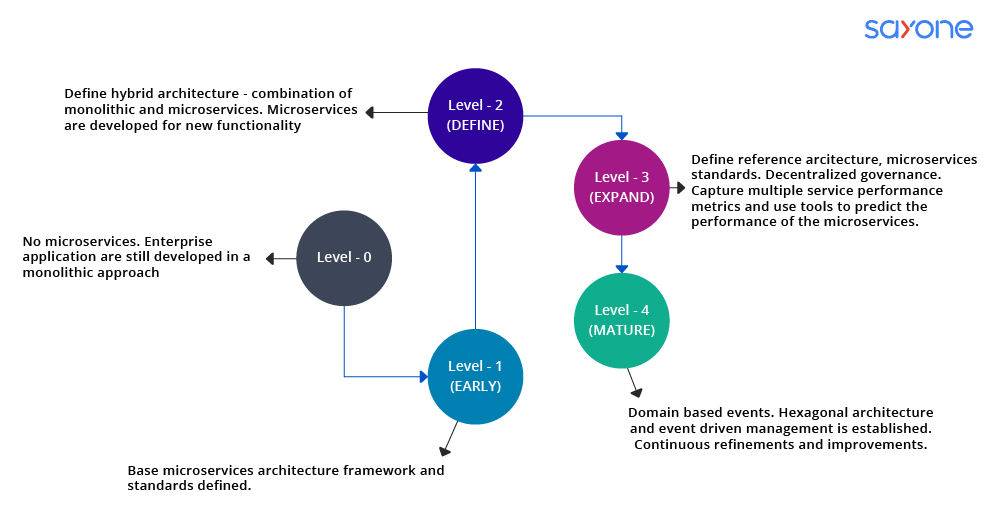
Subscribe to our Blog
We're committed to your privacy. SayOne uses the information you provide to us to contact you about our relevant content, products, and services. check out our privacy policy.

Real PradDecember 10, 20218 min read

Generating table of contents...
If organizations that have already migrated to a microservices setup, 78% of users say that their businesses will only increase their time, effort, and money invested in the microservices architecture. One fundamental question is when should a business shift to microservices architecture? The superior performance of microservices is always observed only when it correctly fits the application that they are meant for.
If your running application is a simple one or your business is only in its starting stage, it may happen that a tightly-coupled monolithic package becomes easier to design for your setup. A microservices application, on the other hand, requires discernment of design principles and awareness and greater developmental knowledge. This is particularly required when breaking down an application into parts. This means that the organization has to invest more time and effort than on a simpler monolithic application.
So, for organizations, when is the best time to move to microservices? The important decision to choose microservices over monolithic applications depends on two crucial factors: application/business size and the availability of resources.
Whether you are a start-up, an SMB, or an enterprise, it is important to keep in mind that shifting to microservices means you have to keep resources handy for ready disposal. Otherwise, the shift almost always becomes an expensive one in the long term.
Whether your business is a start-up or an SMB, if your business application has a limited scope, then a monolithic package would work best for you. Such an application would handle very few requests, have very few points of failure, and need only data from a single database. These are typical cases when the business can be serviced with a monolithic application package.
Even in such a case, when the business grows in size, i.e., when it has to handle a larger number of customers, the monolithic package starts slowing down when processing customer requests. There is a heavier load on the server and, when there are a higher number of requests, the application becomes increasingly inefficient and the output takes a longer time to process and show up.
If functional requirements for a start-up or SMB increase, then it makes sense to move to a microservices architecture. The advantages thereof are listed below.
Download and read our eBook "Porting from Monoliths to Microservices – Is the Shift Worth It?"
The rule of thumb is to settle for or transition into a microservices architecture only when your application is/becomes large and it needs to be both scalable and flexible.
For any start-up or SMB, the availability of resources is a major factor that can stop you from moving to a microservices architecture.
Startups and SMBs that have monolithic application packages maintain separate teams for functions such as development, testing, deployment, and maintenance. Once the organization shifts to a microservices architecture, changes are imperative.
Each service has a different function to perform. The service needs to go through the entire cycle of development, testing, deployment, and maintenance. Therefore, each service needs a team that has experts in each of these functions.
Looking for the best microservices vendor? Give us a call today.
As the services are autonomous, the teams should be autonomous too. In such an atmosphere, independent teams can make for faster time-to-market solutions. Communication with a different service depends only on the extent of coupling with the specific service.
Before shifting to microservices architecture, it is important for enterprises to grade themselves on the basis of a pre-requisites chart comprising the following:
A clear vision of the target microservices architecture
Form teams based on business needs.
The management has to form, manage, and govern many teams for a stable DevOps environment.
Team members should have the necessary competencies to handle distributed systems and take a product from concept stage to retirement.
Entire teams should be made knowledgeable about the requisite technologies so that they are on par to handle the service.
Read our blog "How Microservices Architecture Consulting Services can Help."
The stakeholders should be able to select the right microservices platform from one that is flexible, scalable, cloud-ready, and resilient.
should be conversant with tools like Docker to be able to manage and leverage containerization.
Organizations should be equipped with automation servers to enable CD/CI for quick updates and versions to be rolled out.
Should be ready to adopt orchestration and infrastructure-as-a-service (IaaS).
Be ready for the long haul.
Any business can first evaluate itself based on these prerequisites.If the answer to all the questions in this self-assessment chart is a resounding yes, then the enterprise can think of shifting its operations to a microservices architecture.
This model can help enterprises assess their position on the readiness to shift to microservices. It is a good yardstick that can tell an enterprise where it stands and what it takes for its organization to shift to a microservices model of operation.
In short, the maturity of the shift to microservices can be evaluated on the basis of the following parameters:
For each of these parameters, the enterprise can grade itself as belonging to a specific level. According to the specific level, they can rate their maturity in the specific area, with 0 meaning "not yet ready" and 4 meaning "ready for the shift".

Based on recommendations, the organization can then formulate a plan to shift to a microservices architecture.
Thus, a microservices architecture implementation journey for an enterprise will most likely take place in a phased manner, starting from scratch or transforming their existing legacy software part by part.
Do you want to migrate to microservices? Talk to us today!
As far as startups and SMBs are concerned, it is important that they adopt microservices architecture because this model will help business development and allow the teams to manage the infrastructure better, innovate faster, and reduce the overall cost of adding new features to the app.
At Sayone, we design and implement microservices systems that do not have complex architectural layers, and this enables the services to deliver exceptionally fast performance. Moreover, we provide services that are significantly decoupled, allowing you to launch independent services and not end up with the usual inter-dependent microservices that work more or less like a monolith.
We design the microservices keeping in mind the margin required to allow for the transition into the new system of your organization’s legacy architecture as well as expand into the cloud system. Our microservices comprise lightweight code, and we provide competitive pricing options for our clients.
Our microservices are built according to the latest international security guidelines that ensure the complete safety of all the data. We also ensure that we deliver the services within the stipulated deadlines and we always guarantee a quick turnaround time for our clients. Equipped with the best infrastructure and the latest tools and technologies, our expert developers will provide you with the best microservices that are easily scalable, enabling a good ROI in the shortest period of time.

We're committed to your privacy. SayOne uses the information you provide to us to contact you about our relevant content, products, and services. check out our privacy policy.

About Author
Co-founder and CEO at SayOne Technologies | Helping startups and enterprises to set up and scale technology teams- Python, Spring Boot, React, Angular & Mobile.

We collaborate with visionary leaders on projects that focus on quality